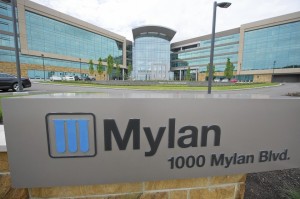Remember years ago when generic drugs had the promise of drastically lowering prices of the superstar medicines when the patents expired. Prozac was one of the first drugs that had that allure. And there is a story behind that.

When Prozac came out it was the first serotonin acting antidepressant. It had far fewer side effects. It did not constipate you, make you dry and drowsy and as my early deep South patients said, it didn’t take my Johnson away.” [But actually, it did that also in some fellows.]
And Prozac came out at the end of President Reagan’s administration when de-regulation had begun to hit its stride. In my highly speculative, inferential view of the drug industry back then, the companies looked around the national landscape and decided the regulation and informal strictures upon drug pricing were gone, that the Feds in the form of the Department of Justice AntiTrust law enforcement bodies would not be unleashed upon them. And so, the first drugs that started to come out in those days that truly represented NEW medicines in terms of their modes of actions and improved efficacies such as Prozac, were suddenly priced many times the usual and customary prices ranks of their ancestral brethren. Prozac and its following related serotonin blocking antidepressants that came out in the 1990s were priced MULTIPLE times higher than the preceding generations of tricyclic antidepressants.
This happened in other medication families, such as the anti-lipid (cholesterol, blood fats) medications, more potent antibiotics, the several new category anti-hypertension medications, but especially the new oncology cancer drugs. Those latter drugs still set records for their cost to this day. [I should know, I take two currently and owe my ongoing gift of longevity to them, but their cost still takes my breath away.]
Then, the patents of many of this ‘generation’ of medications that started to come out in the very late 1980s and through the 1990s, ran out and expired. And generic drug manufacturers raced onto the scene offering non-branded chemical twins of those previously outrageously expensive drugs and all of us millions of patient-consumers were happy at the cost relief we were afforded. The system of patent expiration and market lowering of prices through generic medications WORKED. Competition among the secondary off-patent drug companies lower prices the way they were supposed to. The American model of market competition reaffirmed our beliefs in this system and we worshipped at the altar of purses relieved by drug discounts.
Then something started to happen somewhere in the early 2000s. The generic manufacturers started to GET BIG. They bought each other, with the model of mutual cannibalization leading to huge (or “yuge”–I am not sure which adjective applies here LOL), generic drug companies. And for a while, their claims of bigger manufacturing efficiencies preserving cheaper prices lulled us into naive ignoring of what this trend really meant.
By 2014, a new trend had emerged in price gouging. But first, to entities that did not hit the consumer individually so directly, but rather to the national drug middle man, the national drug store chains, the pharmacy entities selling to the national managed care companies. Those entities initially bore a fair amount of the early years of price increases, trying to retain subscribers, large health plans and to stay competitive. And we consumers let them fight the battles, absorb the sting of increasing costs and happily assumed the behemoths in the healthcare ‘industry’ that we no longer comprehended would duke it out and protect us.
I cited the year 2014 above as a sentinel boundary because in that year the first big anti-price fixing lawsuit came to be brought against the real culprits, our former friends, and beneficiaries, the generic drug manufacturers and marketers.
It turned out that those companies had morphed into the typical monopolistically large company. It seems that often when companies reach a certain enormous critical mass in their particular marketplace, they start to take advantage of their size and try, and often succeed, in controlling their marketplace. They eat up more of their competition and eliminate their rivals, removing that usual checks and balances set of economic controls attendant to free-market competition. And they can do so, since if they in the class of company Death Stars, they usually possess enormous cash reserves and can dominate the forces in their marketplace, such as advertising, opening large numbers of stores, etc.
And, then they start to look for other means of expanding their economic dominance outside the application of ordinary marketing and production. They start to work with the few remaining equally dominant rivals in their industry by working to set the prices of their goods MUTUALLY. In other words, price-fixing. And this started to happen in the generic drug industry. And by 2014 the lawsuits by states and the Federal government’s corrective enforcement bodies started.
And the depth of price-fixing was bold, audacious and as bad as the scandals around the price of Epi-Pens and other medications that lit up the ire of the public in the past several years. Expect that it involved hundreds of generic medications and dozens of generic manufacturers. The cost to the public began to be conservatively calculated as running into the many, many billions of dollars.
An explanatory article from a litigation firm offers just about as good an explanation as I have found regarding this whole mess. It also defines for readers not familiar with the generic drug world, the in’s and out’s of the terms and the relationship of brand name drugs, their patent lives, and the generic drugs. Generic Drug Price-Fixing Lawsuit, from the firm NastLaw.
A listing of many of the firms involved in the price-fixing include several well-known names that are indeed giants in generic medicine pharmaceutical constellation:
- Mylan Pharmaceuticals
- Teva Pharmaceuticals
- Actavis
- Heritage Pharmaceuticals
- Impax Laboratories
- West-Ward Pharmaceuticals
- Par Pharmaceuticals
- Aurobindo Pharma
- Mayne Pharma
- Lannett
- Sun Pharma
- Upsher Smith Laboratories
- Mutual Pharmaceuticals
- Sandoz
- Perrigo
- Fougera Pharmaceuticals
- Taro Pharmaceuticals
- Dr. Reddy’s Laboratories
- Zydus Pharmaceuticals
As usual, I like to offer the reader-selected news pieces that report on the trends and phenomenon that I ardently discuss. One recent article, Price of an OCD drug jumped 1,200%. State attorneys general blame price-fixing focuses on an old psychiatric drug, clomipramine. When it came out it was moderately costly but then it went generic relatively early in its life as it had been an old drug on the research shelf of forgotten drugs [a fascinating story by the way]. Then it was caught up in this national price-fixing orgy by the generics. This report cited above, very aptly illustrates what happened in many instances of recent generic price-fixing.
A notable issue is that this drug was not tossed on the heap of many other old generics and lost in a puddle of several look-alike drugs. Clomprpamin had special, money magnetizing features. It was one of only a few drugs that worked on its condition, OCD, or obsessive-compulsive disorder. It had a large target patient cohort, millions. It had proven itself and a huge number of patient-consumers were already happily taking this prescribed drug that was a miracle in their lives, freeing them from the truly ghastly confines and disabling, total life-disrupting clutches of OCD. And their psychiatrists utilized this drug in confidence and medical subscription of it was not universal but very very high, as good old Prozac also helped a minority percentage of OCD patients.
Currently, the investigations [such as: EXCESSIVE PRICING OF OFF-PATENT PHARMACEUTICALS: HATCH IT OR RATCHET? by JENNIFER L. GRABER, New York University Law Review, Volume 92, Number 4, October 2019; and In the United States District Court for the District of … – Maine.gov] attendant to these various gargantuan anti-trust, price-fixing lawsuits are completed and their fascinating reports are easily available online for any curious reader. The suits are starting to draw to their conclusions. Some of the investigations were aided by some high-level drug company executives involved in these massive fraudulent conspiracies, have turned “state’s evidence,” and cooperated with the plaintiffs.
So now, several dozen generic drug companies, stand apparently close to receiving severe penalties. Judges sound ready to affix verdicts that in anyone’s view, have to emerge as GUILTY as hell in my view. Fines should be in the hundreds of millions, if not billions of dollars for the biggest. Executives should be fined right down to their golden umbrellas stands and go the jail for years. In my view, their sentences should last through their remaining ‘prime’ years of earning power as business moguls and they should be barred from every business and manufacturing-related type of employment except fast food grill production or manning/personing the picker line of recycling computer components for precious metals [to lend their ‘positions of penalty’ some glamour].
So, stick around your favorite business news sources. In the not too distant months to come, we shall likely hear the verdicts that I hope will inject marketplace competitive corrections into the not so level playing field of generic medication pricing for the last 15 years or so of price-fixing tricksterism.
Another correction that needs to be reinserted into our national marketplace of commerce, must/should be the resurrection of anti-trust and anti=price fixing regulatory and law enforcement bodies. We have worshipped at the false idol of total de-regulation for nearly 40 years and it has cost us dearly.
Continue reading “Generic Drug Houses Face Price-Fixing Lawsuits”
